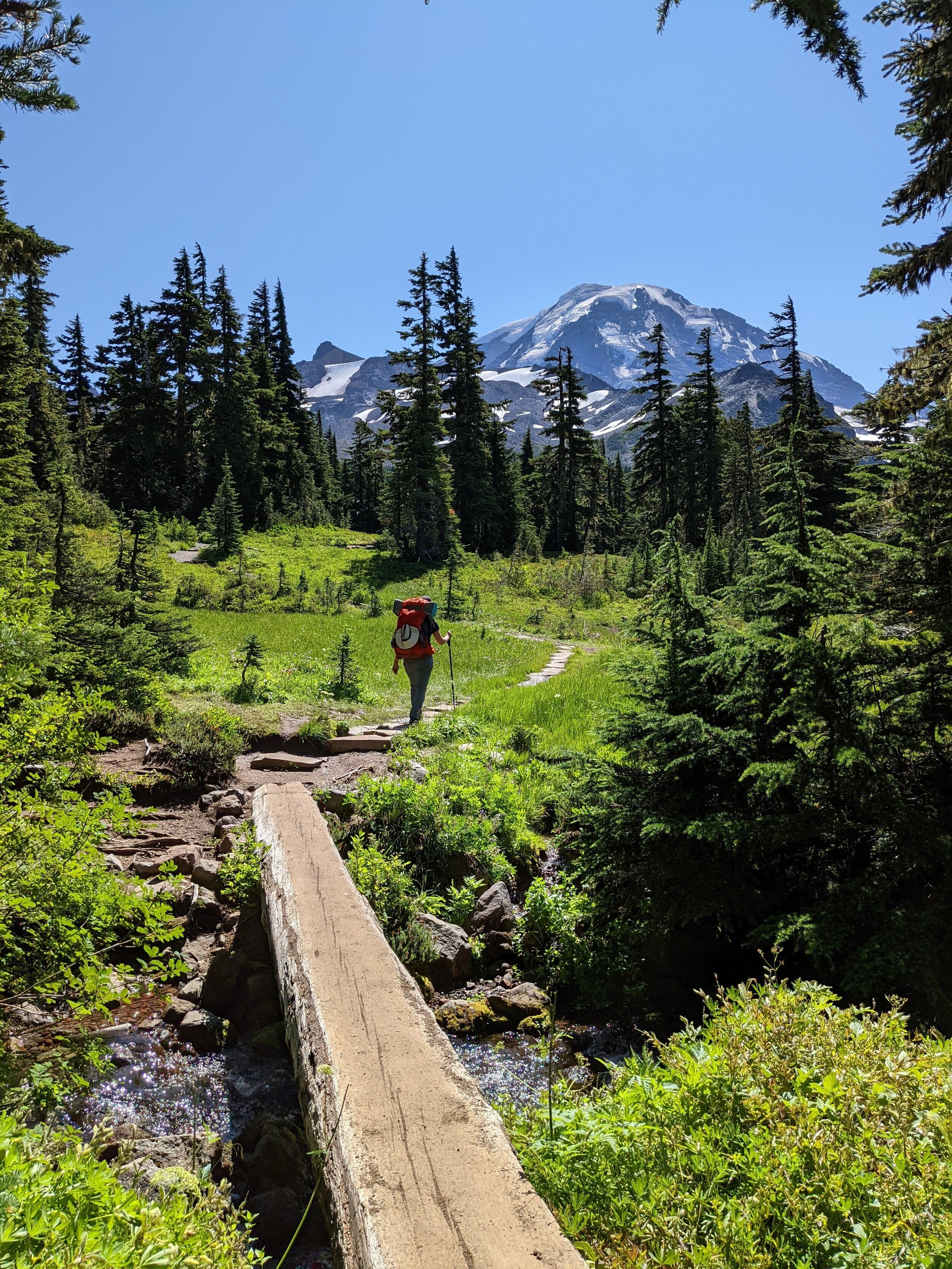Wonderland Trail
When Brian first proposed this idea — the two of us, the 93 mile Wonderland Trail — back in February, I was immediately sold. It seemed like the perfect amuse-bouche to begin our year of travel, especially because we are planning a number of long walks as a family. And from the safe remove of early spring, the fact that the trail is notoriously arduous seemed delightful; it had the feel of a real adventure, something we could tackle together and likely succeed at, but for which our success wasn’t entirely guaranteed. But as the time came closer to our trip, I started to worry about my ability to actually, you know, do it. I’m middle-aged; I’m no athlete. I run a few miles a few times weekly; I do a little YouTube yoga and swing my kettlebell around in the kitchen when the mood strikes. Can I walk 93 miles? More to the point, can I walk up (and down) 25,000 feet?
At the trailhead
The overall lesson of the experience was: yes, I can. I can walk 93 miles in 9 days. I can walk up and down 25,000 feet. I can!
It really looked like this
Having said that, here’s another facet of the truth: my middle aged non-athlete body got pretty beat up in the process. I came into the experience worried about my recovering left ankle sprain (?avulsion fracture) and my left wrist pain. But during the walk I worried more about my infinite mosquito bites, my soaking wet socks and freezing cold feet. Then, my sunburnt shoulders. Then, my right-sided anterior knee pain (?patellofemoral pain syndrome). Then, my flea bites! And finally, after getting back home, when my right foot and ankle swelled up dramatically: my retrocalcaneal bursitis. Ten days on I’m more or less back to normal and have resumed running and kettlebelling. My right knee is a little sore and the area just behind my right Achilles tendon is still swollen. But otherwise I seem to be not dramatically worse for the wear.
Even so, I spent a good portion of the trip thinking about discomfort, in the acute/specific sense but also more generally and philosophically. There’s Katy Bowen and her point about engineering “nutritious movement” out of the modern built environment. There can be such total comfort in our furniture that all our muscles go slack. It’s literally no work to melt into a couch, very different from standing or squatting or even sitting on the ground. Then I read (and reread) Michael Easter’s excellent recent book on discomfort, on the specific value of not insisting, every moment, on comfort. On saying yes to adventure even though it is likely to produce physically uncomfortable sensations.
And here is where it all gets interesting. Backpacking, even under good circumstances, can be pretty uncomfortable. For one thing, carrying a heavy pack is uncomfortable. Walking ten or so miles each day might be comfortable on flat or gently sloping terrain but is work on the (steep) ups and painful on the (steep) downs. So as I tramped along I found myself wondering about the meaning of discomfort. Does it signal danger? Or something more benign? And how important is it? How much attention does it deserve? Maybe, as Brian annoyingly/cheerfully advises, I should ignore discomfort entirely.
This is fine: snow and mosquitos AT THE SAME TIME
The other thing I realized is that often when I have a vague sense of dissatisfaction with my physical comfort, if I actually query it with any specificity, I discover that I’m far more comfortable than I initially guessed. As the miles mounted, I started to enumerate the various axes of comfort and discomfort. The first few I considered were hot, cold, wet. Then pain. Then itchy. Then hungry, thirsty.
Annoying/cheerful
As a thought experiment, I created a quantitative scale; each of ten variables could be assessed either as a binary or on a ten-point scale themselves then summed; this provides an obvious way to weight the most noxious elements (likely pain is more important than itchy? I think?) and a convenient hundred point summary score. I tinkered with my scale as a hiked. For example, what about nausea? What about “fear of imminent bodily injury”? Does that count as discomfort?
FYI, this is what “fear of imminent bodily injury” looks like
And here is where the thought experiment became practical: when I actually forced myself to be honest about my comfort and to notice not just discomfort but also all the ways in which I was lacking discomfort (which of course means I’m comfortable!) I realized I’m actually pretty damn comfortable all the time, even backpacking. Maybe I’m feeling a little cold, or I have to pee, or this hill is so steep. But in each case, I found that I knocked off a point or two on a single scale and the rest were perfect tens.
THERE WERE TWO OF THESE
Other times I queried my body and realized, I’m entirely comfortable! I have literally no physical complaints. But if I hadn’t asked myself the question, I wouldn’t have even noticed this comfort perfection. So like, I can be kinda miserable in the moment and then realize, hey, I’m a 94! Or I can be sitting on a log in camp, not thinking about much, and realize, hey, I’m a 100!
Wild berries on the trail: blue, salmon, lingon, huckle (and currants)
Ultimately Brian is probably right that discomfort isn’t worth much consideration. If I insist on perfect, uninterrupted comfort I’ll never see or do anything beyond my couch. I’ll never know if I can walk 93 miles. (I can!)
Back at the trailhead nine days later









